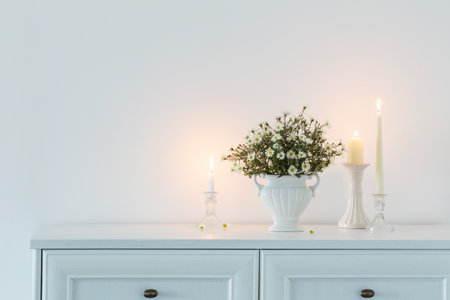Understanding the Bagua Map: An Introduction
The Bagua Map, an essential tool in the ancient Chinese practice of Feng Shui, serves as a blueprint for harmonising spaces through the mindful arrangement of energy, or “qi.” Originating over 3,000 years ago, its purpose is to map out key life areas—such as health, relationships, and prosperity—onto the physical layout of a space. Though deeply rooted in Eastern philosophy, the Bagua Maps core principles have found resonance far beyond its origins. In recent years, British homeowners and interior designers have increasingly embraced this method to foster balance and well-being within contemporary living environments. The relevance of the Bagua Map in modern British homes lies not only in its spiritual undertones but also in its practical approach to creating harmonious spaces that reflect both personal aspirations and a sense of place. As urban living evolves and people seek more meaningful connections with their surroundings, understanding the foundation and purpose of the Bagua Map provides a valuable framework for enhancing everyday life across the UK.
2. Decoding the Bagua: Key Areas and Their Significance
The Bagua Map, central to Feng Shui, divides living spaces into eight distinct zones, each representing a key aspect of life. When applied in British homes—from Georgian terraces to contemporary flats—these zones can align with both traditional values and modern lifestyles. Understanding each area’s symbolism helps create harmony, much like arranging a well-balanced English garden or setting up a thoughtfully curated tea corner.
| Bagua Area | Life Aspect | British Cultural Connection |
|---|---|---|
| Wealth & Prosperity (Xun) | Abundance, success | Savings jars on a mantle, family heirlooms symbolising legacy |
| Fame & Reputation (Li) | Recognition, social standing | Displaying honours, framed degrees or sporting trophies |
| Love & Relationships (Kun) | Romance, partnerships | A cosy settee for two by the fireplace; wedding photographs on display |
| Family & Health (Zhen) | Ancestry, wellbeing | A gallery wall of family portraits or favourite books passed down generations |
| Centre (Tai Chi) | Balance, unity | A round dining table where everyone gathers for Sunday roast |
| Children & Creativity (Dui) | Youthfulness, inspiration | A craft nook or play area filled with children’s drawings and art supplies |
| Knowledge & Wisdom (Gen) | Learning, self-cultivation | A reading nook with classic British novels or a study featuring maps of the UK |
| Career & Life Path (Kan) | Professional journey, purpose | An entryway with an umbrella stand—symbolic of new beginnings and daily routines |
| Helpful People & Travel (Qian) | Support, guidance, mentors | A bulletin board with postcards from friends abroad or reminders of community events like village fêtes or charity fundraisers |
The Bagua’s layout encourages mindful placement of objects and décor to reflect personal aspirations within the context of British culture. Whether it’s integrating a vintage tea set in the Wealth area or hanging up family crests in the Family zone, each choice enhances energy flow. By decoding these areas and their significance, homeowners can blend the ancient wisdom of Feng Shui with the charm and traditions of British living spaces.
![]()
3. Applying the Bagua Map to British Floorplans
Integrating the Bagua Map into British homes requires thoughtful consideration of local architectural features and spatial layouts. Here is a step-by-step guide tailored for common British living spaces, such as terraced houses, flats, and Victorian homes.
Step 1: Select Your Floorplan
Begin by obtaining or sketching an accurate floorplan of your home. For most UK properties, this will include entrance halls, lounges, kitchens, bedrooms, and sometimes utility rooms or conservatories. If you live in a Victorian terrace or a converted flat, be sure to include any unusual alcoves or bay windows distinctive to these styles.
Step 2: Identify the Main Entrance
The Bagua Map is traditionally aligned with the main entrance to the home or space. In British homes, the front door often opens directly into a hallway or lounge. Stand at your main entrance looking inward; this perspective forms the “mouth of chi” and sets the orientation for overlaying the Bagua Map.
Step 3: Overlay the Bagua Grid
Visualise or draw a nine-square grid (three rows by three columns) over your entire floorplan. Each section represents a life area (such as Wealth, Health, Relationships). For narrow terraced houses, you may need to adjust for elongated layouts – stretch the grid proportionally so each sector covers part of your living space.
Adapting for British Home Types
- Terraced Houses: Often long and narrow, focus on aligning the bottom edge of the Bagua with your front door wall. Don’t worry if some areas fall outside – simply apply remedies where possible within your actual living space.
- Flats: Use your flat’s entrance (not necessarily the building’s main door) as the starting point. In open-plan flats, define zones using furniture placement to demarcate Bagua areas.
- Victorian Homes: These often have bay windows and split-levels. Apply the map to each floor separately and adapt sectors for unique features such as under-stair cupboards or fireplaces.
Troubleshooting Irregular Spaces
If certain Bagua sectors fall outside your home’s physical structure (common in L-shaped layouts), you can symbolically represent these areas with décor elements such as mirrors or plants placed strategically indoors.
This method ensures that whether you’re in a classic semi-detached house in Surrey or a modern flat in Manchester, you can meaningfully apply the principles of energy mapping using the Bagua Map adapted for British living environments.
4. Aligning the Map: The Role of Orientation and Entryways
Applying the Bagua Map to British living spaces requires more than just placing a diagram over your home’s floor plan. One of the core considerations is the orientation of the map relative to your entryway, which acts as the energetic “mouth” of the property. In traditional Feng Shui, the Bagua Map is commonly aligned with the main entrance. However, British homes present unique architectural quirks that can complicate this practice.
Understanding British Entryways
British architecture often features varied entry points—such as side doors, porches, or even rear entrances—especially in terraced houses or period properties. This variability means that determining the “main” entryway for energy mapping can be less straightforward than in other cultures where one grand entrance predominates.
Main Entrance vs. Practical Entrance
| Type of Entrance | Typical Use in UK Homes | Bagua Map Placement Guidance |
|---|---|---|
| Main Front Door | Traditional focal point, sometimes rarely used if facing busy street | Standard Bagua alignment; use if it feels most ‘official’ or symbolic |
| Side/Back Door | Often used daily due to parking or garden access | Consider aligning Bagua here if it serves as primary family entry point |
| Shared Entrances (Flats/Maisonettes) | Common in multi-unit dwellings; leads to private hallway or stairwell | Apply Bagua at the door leading into your personal living space, not shared corridor |
Adapting the Map to Unique Floor Plans
The asymmetrical layouts common in Victorian terraces or converted flats may challenge a perfect overlay of the Bagua grid. Instead, focus on intention: align the bottom edge of the Bagua with your chosen entryway, accepting irregular shapes and missing corners as part of your home’s character. In such cases, practitioners often recommend extending Bagua “remedies” or enhancements into adjacent spaces or using mirrors and colours to symbolically complete missing areas.
Cultural Adaptation and Personal Intuition
Ultimately, while tradition provides guidelines, adapting Feng Shui principles to British homes invites a balance between structure and intuition. Consider both historical context and your own patterns of movement through the space when deciding how to align your Bagua Map for optimal energy flow.
5. Customising Recommendations: British Lifestyle and Aesthetics
When incorporating the Bagua Map into British living spaces, it’s crucial to tailor recommendations to fit the diverse spectrum of British interior styles. From the pared-back charm of minimalist flats in London to the vibrant, characterful homes found across the UK’s countryside, Bagua guidelines can be thoughtfully adapted to suit individual tastes without compromising on cultural resonance or aesthetic integrity.
Adapting Bagua for Minimalist British Interiors
Minimalism is a popular choice in many modern British homes, particularly in urban settings where space is at a premium. To integrate Bagua principles here, focus on subtle zoning rather than overt decoration. Use neutral colour palettes corresponding with the Bagua zones—such as soft blues for knowledge and natural greens for family—to maintain a calm, uncluttered look. Incorporate functional objects that serve both practical and symbolic purposes; for instance, a simple wooden bowl in the wealth corner can represent abundance without disrupting minimalist sensibilities.
Bagua in Traditional and Eclectic British Homes
For those who favour eclectic or traditional décor—think Victorian terraces or country cottages—Bagua mapping offers an opportunity to enhance existing layers of character. Emphasise personal heritage by integrating family heirlooms or locally sourced art in relevant Bagua sectors. Rich textures, patterned fabrics, and curated displays can all support energy flow when placed with intention. For example, placing cherished books in the wisdom area or using vintage mirrors to expand the recognition zone are ways to blend Feng Shui guidance with distinctly British design elements.
Respecting Architectural Features
British homes often feature unique architectural quirks such as bay windows, fireplaces, or period mouldings. Instead of concealing these features, use them as focal points within your Bagua layout. A fireplace, for example, might anchor the fame area (south) and become a site for displaying meaningful objects that reinforce positive energy according to Bagua teachings.
Balancing Practicality and Energy Flow
The key to successfully integrating Bagua principles into any British home lies in balancing aesthetic preferences with everyday practicality. Choose enhancements that feel authentic: fresh flowers from local markets for vitality, woven baskets for organisation in communal areas, or artwork reflecting local landscapes. Ultimately, adapting the Bagua Map should feel like a seamless extension of your lifestyle—enhancing wellbeing while honouring the unique spirit of your home.
6. Common Pitfalls and Troubleshooting
Recognising Typical Mistakes in Bagua Application
When incorporating the Bagua Map into British living spaces, several frequent missteps can undermine the intended energy flow. A common pitfall is rigidly overlaying the Bagua on homes with unconventional layouts—such as Victorian terraces or converted flats—without adapting to the property’s unique characteristics. Another error arises when homeowners focus solely on decorative elements, neglecting the underlying principles of clutter removal and functional arrangement that are core to effective energy mapping.
Cultural Adaptation Barriers
British architecture often features irregular rooms, narrow corridors, and multi-level designs, which can make a textbook application of the Bagua challenging. Additionally, there may be scepticism about feng shui practices due to cultural differences or misconceptions about its relevance in Western contexts. These barriers can lead to half-hearted implementations, resulting in little noticeable benefit.
Practical Advice for Overcoming Obstacles
- Adapt the Map: Rather than forcing a perfect alignment, interpret the Bagua flexibly by using main entrances or significant transition points as your reference. Embrace the spirit of the Bagua rather than its strict geometry.
- Prioritise Function Over Form: While aesthetics matter, prioritise clear pathways, natural light, and decluttered zones. This approach aligns with both feng shui principles and practical British sensibilities.
- Start Small: If overwhelmed by scepticism or complexity, begin with one room—often the entrance hall or living area—to build confidence and observe tangible results before extending the practice throughout your home.
Key Takeaway
The most successful integration of the Bagua Map in UK homes comes from a balance of respect for tradition and sensitivity to local context. By avoiding rigidity and embracing adaptability, British residents can unlock new potential in their living spaces while sidestepping common pitfalls.


